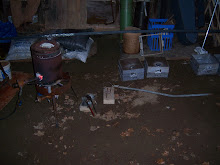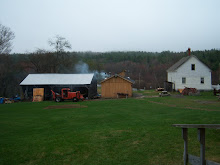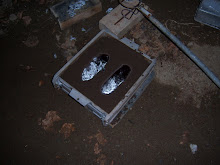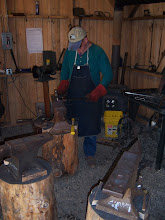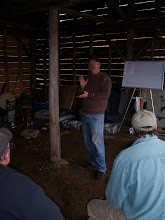Dear All (Everyone that has been to, used or expressed interest in using the smithy located at The Curran Homestead),
Since The Curran Homestead's Spring, 2010 blacksmithing classes are winding down, The Curran Homestead is planning some summertime workshops, free smithy times, and metal workshops. Adriaan Gerber and I are working out the details for some beginning and intermediate beginner courses that will likely be of the 4-Day Intensive Weekend or 1-Week Intensive variety. The size will be limited to 5 students for each of these classes or workshops. There will also be some other knife making workshops offered, so stay tuned at our new blog: "Curran Homestead Blacksmithing" at (curranhomesteadblacksmithing.blogspot.com). This will include all pertinent information for our summer offerings in the days to come, including syllabae. For now the following are tentatively scheduled and will depend on your expressed interest via email to me ( Check out the full description of the class activity below):
1. Intensive Beginners' Blacksmithing Course---4 Day Weekend Class (Adriaan Gerber, Instructor)
Available Dates: June 25-28, July 2-5, 9-12, 30-Aug. 2., 2010.
2. 3-Day Make Your Own Viking/Bearded Axe at the Smithy (Adriaan Gerber, Instructor)
Available Dates: May 28-30, June 5-7, 11-13
3. Intensive Intermediate Beginners' Course---4 Day Weekend Class (Adriaan Gerber, Instructor)
Available Dates: June 25-28, July 2-5, 9-12, 30-Aug. 2., 2010.
4. Forging a Knife and /or Tomahawk from Welded Cable Steel ( Looks similar to Damascus Steel )---2 Day (Adriaan Gerber, Instructor)
Let us know whether it is the tomahawk or knife you prefer?
A number of people have informed me about their desire to have free forging time after classes end on June 15. The Saturday hours at the smithy were reduced to 9-11 AM awhile back because of low attendance. For the past month, only 2 or 3 people have been showing up on Saturdays, and this is no doubt related to the great weather we have been having. Free forging on Saturdays will end at 11AM on June 12, 2010. Adriaan Gerber is interested in working at the smithy weekday nights or possibly on a weekend day, so we tentatively plan on posting his schedule so others can use the smithy during the times he will be there to supervise. There will be a cost for using the smithy at this time, and this cost will cover coal and metal use. This is tentatively planned to be somewhere in the 5-10 dollar range for at least a three hour time block. Email me, if you are interested with specific days and times you would like to see the smithy open.
We are also interested in doing a Sunday barbecue and all-day forging session. This is tentatively scheduled for Sunday, June 27, 11-5. Barbecue chicken and free range grass fed Scottish Highland beef will be cooked outside the smithy, and there will be homemade potato salad, macaroni salad , and iced tea/lemonade/water. The price per person will be $12.00 to cover cost and preparation of food and donation to The Curran Homestead. The forging will be focused on creating heavy duty strap hinges for the doors of the equipment shed behind the smithy as well as a stand for the hammers and tongs that are in the smithy ( anyone willing to send a design for such a stand is welcome to do so); organizing the tongs, hammers etc. in a wall hanging or free standing configuration has long been talked about and is a necessity to organize the smithy. If you are interested, I will need a head count, so email me.
As you may recall we had a metalcasting workshop awhile back with Peter Grant. Peter and I have worked out the details for another metalcasting workshop. See the details below or visit the new blog site.
Tentative Metal Casting Workshop Scheduled
The Curran Homestead has tentatively planned its second metal casting workshop with Peter Grant to be offered on Saturday, June 12, 2010, 9AM-3PM; there will be a break for lunch. The workshop is entitled "Make Your Own Sandcasting Pattern and Bring It."
This second workshop, which will review a portion of the material covered in the first metalcasting workshop, will focus exclusively on the sandcasting and small refractory lined propane fueled forges that we will be working with, so new attendees are welcome and won't come to the thing with a disadvantage. The first workshop was a comprehensive overview of all types of metalcasting whereas this won't be; it will ony address safety and the process associated with a small propane fueled forge. This tentative workshop will likely not be limited to only an aluminum melt as the first workshop was;we may try our hand at a bronze melt as well using another crucible we plan to purchase with monies garnered from our first metal melt. The site of the melt will be the open equipment shed at The Curran Homestead, so rain will not effect the outcome of the planned program.
The cost per hands-on student (limited to five for safety reasons) is tentatively set at 35 dollars, which will partially be used to buy more expendible crucibles and scrap metal, aluminum and brass, for melting down in the future. The cost for onlooker students is 15 dollars.If you are seriously interested in being a hands-on student, or an onlooker, please email me (rpschmick1@aol.com). You can only reserve a spot as a hands-on student by paying by check made payable to: "The Curran Homestead." This check can be delivered in person to The Bangor Letter Shop, Penobscot Plaza, 99 Washington St., Bangor, ME. The five hands-on student places will likely be reserved quickly so let me know ASAP. Onlookers can pay the 15 dollar fee in person at the Bangor Letter Shop, or simply pay on the day of the workshop; please email me beforehand letting me know that you plan on coming as we would like an idea of our potential turnout. All are welcome. Since this is the last saturday of the Tuesday night class for free forge use, people who will be coming to the smithy from this last class of the Spring schedule will not have to pay to be an onlooker for this workshop ( if you want to be a hands-on participant then the fee is the same as everyone else).
The idea behind this workshop is that a pattern/replica can be made by the metalcasting student on his/her own, and that will be brought to the workshop and set into a mold frame holding the sand that will receive the impression of it. Pattern/replicas are made out of a number of materials including wood, styrofoam ( you will want something very dense, like the blue insulating styrofoam insulation sheeting as it will need to hold sharp details when you carve it), neoprene (?), ceramic, among others.
The potential student can do some independent research on suitable materials for the purpose on the Internet, and this is recommended by Peter, but you might first want to consider how many times you want to make a casting. A wood pattern/replica allows you to make castings over and over again whereas more ephemeral materials might break down, get damaged, and lose desirable details through use. For my own purposes, I plan on trying fast-drying clay. I have experience with ceramics, and I believe I can obtain the desired detail for my project with little effort, and I am not concerned with using my pattern more than once. Of course, wood is more desirable, but I don't presently have tools like a lathe, router,and chisels to make the process seemingly easier. What material you choose may depend on what it is you want to reproduce. In our first workshop a rammer tool was made for each student that would serve them in their preparation of a sandcasting mold in the future. In creating your pattern you should keep in mind that this will be pressed into a mold frame containing a 8 inch square surface area of moist sand. In planning this you might draw a box that is 8 inch square on paper and see what you can fit within those limited parameters.
One of the things we wish to accomplish is to create a bronze plaque to be mounted on the flat face of a boulder at the Curran farm. The boulder will be incorporated into a circular field surround that will contain a planned perennial garden. This plaque will identify one of our generous donors at The Curran Homestead. Peter has recently come up with a process of using stick on lettering to make patterns for plaques and nameplates. We will attempt to do this in bronze.
Let me know, if you are interested in anything in particular. Thanks. Sincerely, Bob
Monday, May 24, 2010
Intensive Beginner's Blacksmithing Course
Day 1 - Morning
Introduction to Safety, Materials and Tools of the Trade. Tapering To A Square Point. Drawing Out Metal. Forging Square Taper To Octagonal And Round. Bending Over The Horn. Twisting. Using the Cross Pein Hammer to forge a basic S-hook.
Afternoon
Tapering To A Square Point. Drawing Out Metal. Forging Square Taper To Octagonal And Round. Bending Over The Horn. Twisting. Decorative Bending. Setting Down Using Half-faced Blows. Forge a Set of 6 Skewers With Fancy Handles.
Day 2 - Morning
Hot-cutting and Splitting. Separating Split Parts For better access. Smoothing Out Cuts Using the Vise. Tapering To A Square Point. Drawing Out Metal. Forging Square Taper To Octagonal And Round. Flattening and Twisting. Forging Out a Meat Fork.
Afternoon
Upsetting. Reducing Metal Width to Form A Neck. Preventing Folds. Flattening. Drawing Down. Bending and Filing Using the Vise. Forging Out a Spatula.
Day 3 - Morning
Preparing for Welding. Upsetting and Scarfing. Fire Control For Welding. Using Flux. Forge Welding. Forging a Spoon.
Afternoon
Preparing for Welding. Upsetting and Scarfing. Fire Control For Welding. Using Flux. Forge Welding a Ring. Punching a Square Slot. Punching Mounting Holes. Forging a Door Knocker.
Day 4 - Morning & Afternoon
Drawing Down. Folding and Welding. Preparing Steel Insert. Welding High-carbon Steel. Cutting and Spreading. Heat-treating High-carbon Steel. Forging a Tomahawk
Metal Requirements:
6’ of 3/16" round pp.
8" of 3/16" x 1/2" pp
1’ of 3/16" x 1 1/2" pp.
1’ of 1/2" sq pp.
2’ of 1/2" round pp.
There’s enough steel for the tomahawk making, plus files.
Introduction to Safety, Materials and Tools of the Trade. Tapering To A Square Point. Drawing Out Metal. Forging Square Taper To Octagonal And Round. Bending Over The Horn. Twisting. Using the Cross Pein Hammer to forge a basic S-hook.
Afternoon
Tapering To A Square Point. Drawing Out Metal. Forging Square Taper To Octagonal And Round. Bending Over The Horn. Twisting. Decorative Bending. Setting Down Using Half-faced Blows. Forge a Set of 6 Skewers With Fancy Handles.
Day 2 - Morning
Hot-cutting and Splitting. Separating Split Parts For better access. Smoothing Out Cuts Using the Vise. Tapering To A Square Point. Drawing Out Metal. Forging Square Taper To Octagonal And Round. Flattening and Twisting. Forging Out a Meat Fork.
Afternoon
Upsetting. Reducing Metal Width to Form A Neck. Preventing Folds. Flattening. Drawing Down. Bending and Filing Using the Vise. Forging Out a Spatula.
Day 3 - Morning
Preparing for Welding. Upsetting and Scarfing. Fire Control For Welding. Using Flux. Forge Welding. Forging a Spoon.
Afternoon
Preparing for Welding. Upsetting and Scarfing. Fire Control For Welding. Using Flux. Forge Welding a Ring. Punching a Square Slot. Punching Mounting Holes. Forging a Door Knocker.
Day 4 - Morning & Afternoon
Drawing Down. Folding and Welding. Preparing Steel Insert. Welding High-carbon Steel. Cutting and Spreading. Heat-treating High-carbon Steel. Forging a Tomahawk
Metal Requirements:
6’ of 3/16" round pp.
8" of 3/16" x 1/2" pp
1’ of 3/16" x 1 1/2" pp.
1’ of 1/2" sq pp.
2’ of 1/2" round pp.
There’s enough steel for the tomahawk making, plus files.
Forging A Viking Axe---3 Day
Forging A Slot Punch. Forging an Eye Drift. Forging a Slitting Chisel. Upsetting and Drawing Out End. Punching and drifting An Eye. Cutting Edge to Accept Steel Bit. Preparing Steel Bit. Welding in Bit. Shaping Edge. Heat Treatment. Sharpening. Making and Fitting handle.
Metal Requirements:
Metal for punches and drifts, maybe 5/8” O-1 or some old chisels or crowbars.
8” of 1” x 1” square pp.
file steel
flux
Metal Requirements:
Metal for punches and drifts, maybe 5/8” O-1 or some old chisels or crowbars.
8” of 1” x 1” square pp.
file steel
flux
Forging a Tomahawk – 1 day
Class Activity:
Forging Bowtie Body. Folding Over and Welding Eye. Preparing Steel Bit. Inserting and Forge-welding Edge. Cut to Length. Draw Out Edge. Drift Eye. File to Final Shape. Heat Treatment. Sharpening. Making a Handle and Fitting. Throwing.
Metal Requirement
2’ of 2” x 3/16” pp.
files
Forging Bowtie Body. Folding Over and Welding Eye. Preparing Steel Bit. Inserting and Forge-welding Edge. Cut to Length. Draw Out Edge. Drift Eye. File to Final Shape. Heat Treatment. Sharpening. Making a Handle and Fitting. Throwing.
Metal Requirement
2’ of 2” x 3/16” pp.
files
Forging A Knife from Welded Cable Steel (no powerhammer needed)
Class Activity:
Preparing the cable for welding.
Forge-welding the cable.
Drawing down the cable to usable format.
Forging knife blank.
Demonstration of etching process.
1’ of cable pp.
flux
Preparing the cable for welding.
Forge-welding the cable.
Drawing down the cable to usable format.
Forging knife blank.
Demonstration of etching process.
1’ of cable pp.
flux
Sunday, May 16, 2010
Tentative Metal Casting Workshop Scheduled
The Curran Homestead has tentatively planned its second metal casting workshop with Peter Grant to be offered on Saturday, June 12, 2010, 9AM-3PM; there will be a break for lunch. The workshop is entitled "Make Your Own Sandcasting Pattern and Bring It."
This second workshop, which will review a portion of the material covered in the first metalcasting workshop, will focus exclusively on the sandcasting and small refractory lined propane fueled forges that we will be working with, so new attendees are welcome and won't come to the thing with a disadvantage. The first workshop was a comprehensive overview of all types of metalcasting whereas this won't be; it will ony address safety and the process associated with a small propane fueled forge. This tentative workshop will likely not be limited to only an aluminum melt as the first workshop was;we may try our hand at a bronze melt as well using another crucible we plan to purchase with monies garnered from our first metal melt. The site of the melt will be the open equipment shed at The Curran Homestead, so rain will not effect the outcome of the planned program.
The cost per hands-on student (limited to five for safety reasons) is tentatively set at 35 dollars, which will partially be used to buy more expendible crucibles and scrap metal, aluminum and brass, for melting down in the future. The cost for onlooker students is 15 dollars.If you are seriously interested in being a hands-on student, or an onlooker, please email me (rpschmick1@aol.com). You can only reserve a spot as a hands-on student by paying by check made payable to: "The Curran Homestead." This check can be delivered in person to The Bangor Letter Shop, Penobscot Plaza, 99 Washington St., Bangor, ME. The five hands-on student places will likely be reserved quickly so let me know ASAP. Onlookers can pay the 15 dollar fee in person at the Bangor Letter Shop, or simply pay on the day of the workshop; please email me beforehand letting me know that you plan on coming as we would like an idea of our potential turnout. All are welcome. Since this is the last saturday of the Tuesday night class for free forge use, people who will be coming to the smithy from this last class of the Spring schedule will not have to pay to be an onlooker for this workshop ( if you want to be a hands-on participant then the fee is the same as everyone else).
The idea behind this workshop is that a pattern/replica can be made by the metalcasting student on his/her own, and that will be brought to the workshop and set into a mold frame holding the sand that will receive the impression of it. Pattern/replicas are made out of a number of materials including wood, styrofoam ( you will want something very dense, like the blue insulating styrofoam insulation sheeting as it will need to hold sharp details when you carve it), neoprene (?), ceramic, among others.
The potential student can do some independent research on suitable materials for the purpose on the Internet, and this is recommended by Peter, but you might first want to consider how many times you want to make a casting. A wood pattern/replica allows you to make castings over and over again whereas more ephemeral materials might break down, get damaged, and lose desirable details through use. For my own purposes, I plan on trying fast-drying clay. I have experience with ceramics, and I believe I can obtain the desired detail for my project with little effort, and I am not concerned with using my pattern more than once. Of course, wood is more desirable, but I don't presently have tools like a lathe, router,and chisels to make the process seemingly easier. What material you choose may depend on what it is you want to reproduce. In our first workshop a rammer tool was made for each student that would serve them in their preparation of a sandcasting mold in the future. In creating your pattern you should keep in mind that this will be pressed into a mold frame containing a 8 inch square surface area of moist sand. In planning this you might draw a box that is 8 inch square on paper and see what you can fit within those limited parameters.
One of the things we wish to accomplish is to create a bronze plaque to be mounted on the flat face of a boulder at the Curran farm. The boulder will be incorporated into a circular field surround that will contain a planned perennial garden. This plaque will identify one of our generous donors at The Curran Homestead. Peter has recently come up with a process of using stick on lettering to make patterns for plaques and nameplates. We will attempt to do this in bronze.
Let me know, if you are interested.
This second workshop, which will review a portion of the material covered in the first metalcasting workshop, will focus exclusively on the sandcasting and small refractory lined propane fueled forges that we will be working with, so new attendees are welcome and won't come to the thing with a disadvantage. The first workshop was a comprehensive overview of all types of metalcasting whereas this won't be; it will ony address safety and the process associated with a small propane fueled forge. This tentative workshop will likely not be limited to only an aluminum melt as the first workshop was;we may try our hand at a bronze melt as well using another crucible we plan to purchase with monies garnered from our first metal melt. The site of the melt will be the open equipment shed at The Curran Homestead, so rain will not effect the outcome of the planned program.
The cost per hands-on student (limited to five for safety reasons) is tentatively set at 35 dollars, which will partially be used to buy more expendible crucibles and scrap metal, aluminum and brass, for melting down in the future. The cost for onlooker students is 15 dollars.If you are seriously interested in being a hands-on student, or an onlooker, please email me (rpschmick1@aol.com). You can only reserve a spot as a hands-on student by paying by check made payable to: "The Curran Homestead." This check can be delivered in person to The Bangor Letter Shop, Penobscot Plaza, 99 Washington St., Bangor, ME. The five hands-on student places will likely be reserved quickly so let me know ASAP. Onlookers can pay the 15 dollar fee in person at the Bangor Letter Shop, or simply pay on the day of the workshop; please email me beforehand letting me know that you plan on coming as we would like an idea of our potential turnout. All are welcome. Since this is the last saturday of the Tuesday night class for free forge use, people who will be coming to the smithy from this last class of the Spring schedule will not have to pay to be an onlooker for this workshop ( if you want to be a hands-on participant then the fee is the same as everyone else).
The idea behind this workshop is that a pattern/replica can be made by the metalcasting student on his/her own, and that will be brought to the workshop and set into a mold frame holding the sand that will receive the impression of it. Pattern/replicas are made out of a number of materials including wood, styrofoam ( you will want something very dense, like the blue insulating styrofoam insulation sheeting as it will need to hold sharp details when you carve it), neoprene (?), ceramic, among others.
The potential student can do some independent research on suitable materials for the purpose on the Internet, and this is recommended by Peter, but you might first want to consider how many times you want to make a casting. A wood pattern/replica allows you to make castings over and over again whereas more ephemeral materials might break down, get damaged, and lose desirable details through use. For my own purposes, I plan on trying fast-drying clay. I have experience with ceramics, and I believe I can obtain the desired detail for my project with little effort, and I am not concerned with using my pattern more than once. Of course, wood is more desirable, but I don't presently have tools like a lathe, router,and chisels to make the process seemingly easier. What material you choose may depend on what it is you want to reproduce. In our first workshop a rammer tool was made for each student that would serve them in their preparation of a sandcasting mold in the future. In creating your pattern you should keep in mind that this will be pressed into a mold frame containing a 8 inch square surface area of moist sand. In planning this you might draw a box that is 8 inch square on paper and see what you can fit within those limited parameters.
One of the things we wish to accomplish is to create a bronze plaque to be mounted on the flat face of a boulder at the Curran farm. The boulder will be incorporated into a circular field surround that will contain a planned perennial garden. This plaque will identify one of our generous donors at The Curran Homestead. Peter has recently come up with a process of using stick on lettering to make patterns for plaques and nameplates. We will attempt to do this in bronze.
Let me know, if you are interested.
Subscribe to:
Posts (Atom)

